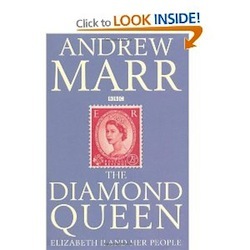Posts in this series:
Diamond Jubilee- The Diamond Queen
- The Queen
- The Queen and I
Published: 2012
Author: Andrew Marr
A decent but unexciting biography of a great woman
This is a big week in British history – Her Majesty the Queen is celebrating her Diamond Jubilee. She has given sixty years of service to the nation (and the Commonwealth) and is only the second monarch to reach this milestone. The UK is Jubilee nuts at the moment, bunting on every street corner, union flag branded goods everywhere and a feeling of goodwill towards the Royal Family that’s unprecedented, at least in my lifetime. I’m an unashamed monarchist, I love the Queen and think the UK would be a much poorer country if we were to become a Republic. To mark the Jubilee all of my posts this week will have a royal theme and then for the rest of June I’ll be celebrating the Best of British. I hope you enjoy what’s coming up.
 Authors have been preparing for this anniversary for quite a while. In the past year or so numerous biographies have been published including respected historian Robert Hardman’s Our Queen
Authors have been preparing for this anniversary for quite a while. In the past year or so numerous biographies have been published including respected historian Robert Hardman’s Our Queen, Sally Bedell Smith’s Elizabeth the Queen
and Victoria Murphy’s image heavy Sixty Glorious Years
. I knew I wanted to start this series with a biography of Her Majesty and decided to go with Andrew Marr’s The Diamond Queen
– written at the same time as Marr was preparing the BBC documentary of the same name, but not strictly a companion to the television programme.
Marr begins with a brief history of the House of Windsor including a quick look at the abdication of the Queen’s uncle Edward VIII and the coronation of her father George VI, a shy man who was unprepared for his new role as King. Marr follow’s Elizabeth’s reign in a thematic rather than chronological order and looks at the Queen’s relationship with her Prime Ministers, interest in foreign and Commonwealth affairs and of course, the death and legacy of Princess Diana.
If you are looking for a book with lots of new information or scandalous gossip then this isn’t the one for you. I don’t think there was anything in here that I didn’t already know (except for the little nugget that a member of the government is held ‘hostage’ at Buckingham Palace during the Queen’s Speech to both Houses of Parliament). Marr’s tone is almost, but not quite, reverential and his respect for his subject shines through.
There is little real insight into the personality or emotions of Elizabeth the woman, wife or mother. Only the testimony of Timothy Knatchbull whose grandfather Lord Mountbatten and twin brother Nicholas were murdered by the IRA offers a glimpse at the warmth that the Queen can show at times of personal tragedy. I imagine that reading Knatchbull’s words are the closest we will ever get to knowing what happened at Balmoral after the death of Princess Diana.
As may be expected given the author’s background in political journalism the book is at its best when examining the Queen’s role as advisor to her Prime Minister. I’ve often heard that the PM’s weekly audience is a great source of support to the head of government, this is the one time that they can be completely honest and know that the person they are talking to doesn’t have half an eye on his (or her) job. Anecdotes are liberally spread throughout the book about the Queen’s quiet but determined influence on her Prime Minister.
A great deal of time is spent on the life and death of Princess Diana – it’s fair to say that this was an awkward time for the Royal Family and the impact of Diana on the Queen and the Monarchy is examined thoroughly. If Marr has affection and respect for the Queen he has nothing but contempt for Diana, which at times felt both unfair and distasteful. Despite her many flaws Diana did bring people closer to the Royal Family than ever before, and more importantly showed that they are just that – a family with ups, downs, mistakes and feuds.
For a book so meticulously researched there were a number of errors that made me wince. When discussing the death of George VI the book talks about Princess Elizabeth flying to Kenya in January 1951. While this may seem like a very minor mistake it’s the kind of error that makes be lose confidence in a book – not something that is idea when reading a biography.
The Diamond Queen is a perfectly decent biography of the Queen, and for fans of the monarchy there’s nothing here that will cause offence. I’m just left feeling a little short-changed and wondering if any of the other biographies published in the past 12 months might have told me a little bit more.

